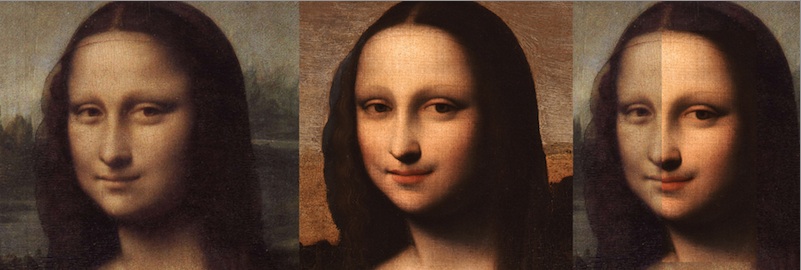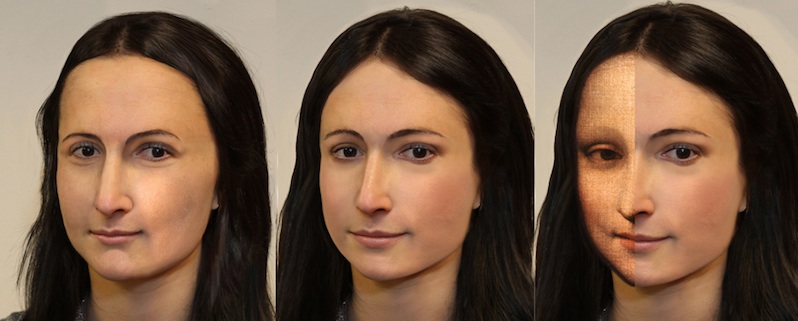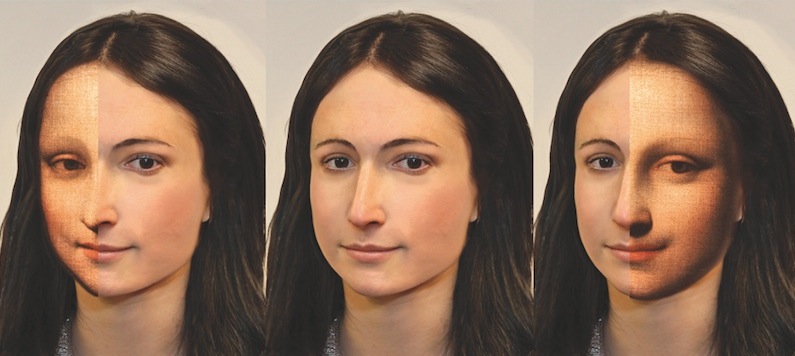As has been exhaustively detailed in other sections of the website, Leonardo likely completed the Louvre ‘Mona Lisa’ c.1516. The youthful image he painted c.1503-06 would then have had to have been ‘age-progressed’, reflecting how Leonardo, basing himself on the earlier version, imagined that Lisa del Giocondo would have looked approximately 11-12 years after he first posed her.
This hypothesis is not as far-fetched as it may appear. Such a progression challenge would have been in line with his genius, and his desire to test the limits of what he could achieve. In addition, Leonardo’s passion for human anatomy and the effects of ageing on the human body are well documented through his notebooks. Having kept the unfinished ‘Earlier Mona Lisa’ with him since his ‘Second Florentine Period’, Leonardo would have used it as the basis on which he would create the Louvre ‘Mona Lisa’ for Giuliano de Medici, ageing Lisa by the number of years since she had originally posed for him in Florence.
In order to advance this significant hypothesis, The Mona Lisa Foundation embarked on a unique and innovative 21st Century experiment that, as far as it is known, had never been tried before in this context. The parameters of the project were clear: assuming that the ‘Earlier Mona Lisa’ was painted c.1503-06, and assuming that the Louvre ‘Mona Lisa’ was executed c.1513-16, this would present an age difference between the two portraits of roughly 11-12 years. Using the famous ‘Mona Lisa’ of the Louvre as a ‘base’, it was proposed to ‘regress’ the age of the woman to see what she might have looked like 11-12 years earlier. This test would result in giving a much clearer idea as to whether (a) the two paintings represented the same person, painted about 11-12 years apart or (b) that the ‘Mona Lisa’ in the Louvre was not after all based on the ‘Earlier Mona Lisa’.
There are many competent forensic artists with the ability to ‘progress’ the age of a person’s picture who do so, often on behalf of various police and law-enforcement departments, security organizations, and not least, for the purpose of finding longterm missing children. But a ‘regression’ involves greater skills, based on years of professional experience. Following a referral from one of the world’s leading forensic anthropologists, The Mona Lisa Foundation sought out the assistance of Joe Mullins, one of the most respected forensic artists in the United States, a practitioner with impeccable credentials.
To maintain the integrity of the whole project, the only image that the artist was given with which to work was a high-resolution photograph of the Louvre ‘Mona Lisa’. Mr. Mullins was given no further material or information of any description about any other painting; nor had he any prior knowledge of the existence of an earlier version. In sequence, the forensic artist converted the image of the Louvre ‘Mona Lisa’ into a digital photograph, and then technically manipulated it to result in what would be in his opinion, an image of how that subject would have looked 11-12 years younger.
Phase 1 of the experiment was concluded when the Foundation received from Mr. Mullins the regressed image in digital photographic form.
Immediately upon receipt, Phase 2 began, and the foundation sent to Mr. Mullins high-resolution scans of the ‘Earlier Mona Lisa’, along with some historical data. The artist was then able to compare for the first time the images of the earlier painting and the ‘younger’ photograph, and then join them together.
The results are not only stunning, but have greatly assisted in the identification of the lady in both paintings, leaving little room for further doubt about the fact that she is one and the same person.
Mullins stated: “The proportions of the face are very similar, the features (nose, eyes, hairline, brows, lips) are all very close in comparing the images. In my opinion, factoring in my experience of dealing with images, comparing them with known individuals, and knowledge of growth and the effects of aging, the two portraits are of the same individual.”
In a rare fusion of science and connoisseurship, a totally novel approach to the question of identity has concluded that if the earlier painting portrayed Lisa del Giocondo, then the Louvre version also portrays her, at the age of about 35; in other words the same lady about 11-12 years later. This evidence confirms the hypothesis that Leonardo would have used the ‘Earlier Mona Lisa’ as a model for the Louvre painting. In addition, this result, combined with the nature of the Louvre painting’s glazing which Leonardo only developed after 1508; the existence of the Prado ’Mona Lisa’ which would likely have been executed at the same time as the Louvre painting; and the Medici commission would validate the opinions of those scholars and art historians who believe that the Louvre ‘Mona Lisa’ was executed c.1513-16, during Leonardo’s stay in Rome.
There are therefore 4 distinct, verifiable and independent reasons to date the execution of the Louvre painting to c.1513-16. In turn, this implies that this painting is not and could not be the Mona Lisa documented by Vespucci and Vasari which was being painted for del Giocondo in Florence in 1503.


